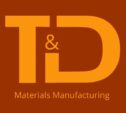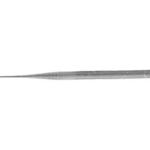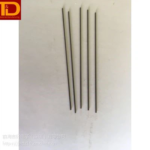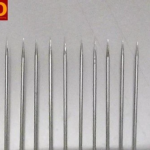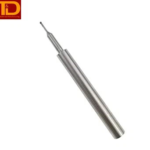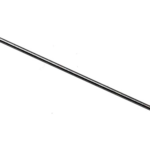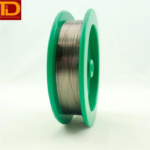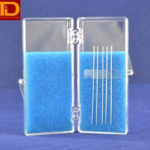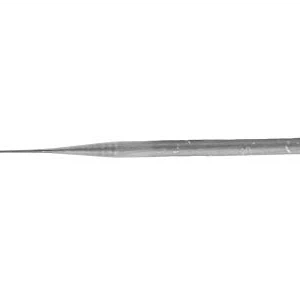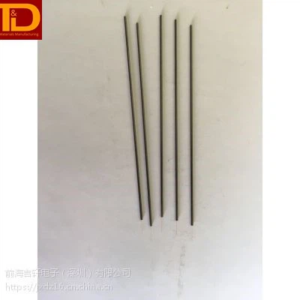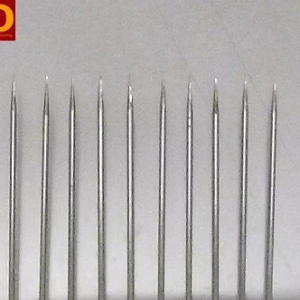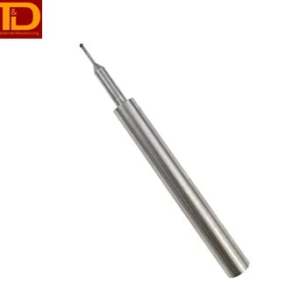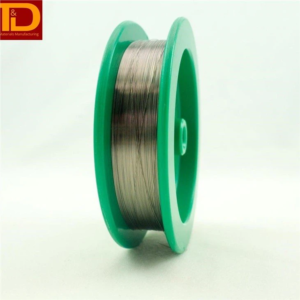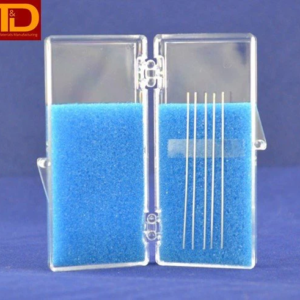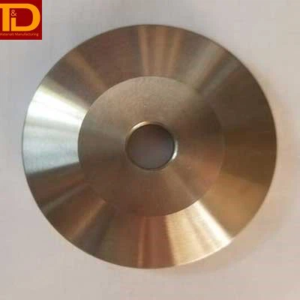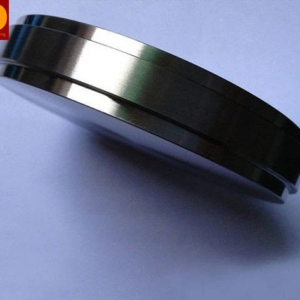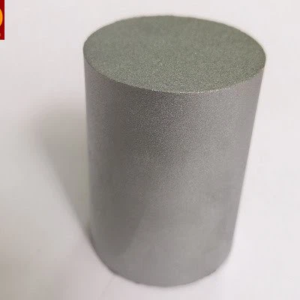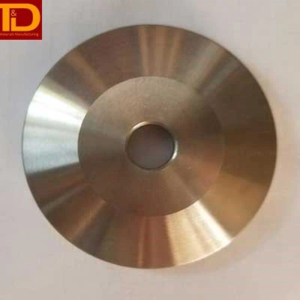Rhenium Tungsten Probe
Tungsten-Rhenium probe needles are specialized microelectrodes commonly used in scientific and medical applications for precise measurements in challenging environments. These needles are crafted from a combination of tungsten and rhenium, providing them with enhanced mechanical strength, high melting points, and excellent conductivity. These traits make them indispensable instruments for achieving precision and reliability in scientific and medical applications amidst challenging environments.
Tungsten and Tungsten-Rhenium Probe Needles
Cantilevered blade-type and epoxy-ring probe cards are commonly employed for testing the majority of integrated circuits. The contact resistance, balanced contact force, and lifespan of the card are directly influenced by the material and shape of the probes. Consequently, specifying the probe needle is a crucial design step for either type of card.
In the case of blade-type cards, the probe needles are affixed to metallic or ceramic blades, which are subsequently attached to a printed wiring board (PWB) to align with the contact pad pattern of the device being tested. In epoxy-ring cards, the probes are organized according to the contact-pad pattern, embedded within an epoxy ring, and the resulting oven-hardened assembly is glued and soldered onto the PWB.
Over the last two years, there has been a significant surge in the adoption of tungsten-rhenium (WRe) needles for constructing probe cards. Traditionally, tungsten (W) probes were favored for their exceptional stiffness, hardness, and wear-resistant properties.
The increasing popularity of tungsten rhenium as an alternative material for probe needles is largely driven by positive feedback from users. Wafer test engineers have discovered that both tungsten and tungsten rhenium materials are proficient in scrubbing contact pads. However, due to their higher hardness, tungsten rhenium probes exhibit superior resistance to tip fouling and overall demonstrate better service-life characteristics.
While attempts have been made to quantify the parameters of probe needles that influence card behavior, certain misconceptions persist regarding the fundamental properties of tungsten and tungsten rhenium probes.
Probe-Needle Metallurgy
Precision-straightened tungsten and tungsten rhenium fine-diameter wires are used in the fabrication of probe needles. The wire drawing process involves pulling and annealing swaged rods through progressively smaller dies. This reduction in the wire’s cross-sectional area leads to an increase in dislocations per unit area, hindering dislocation motion and subjecting the material to significant cold-working. Consequently, the strength and hardness values are systematically increased.
Incorporating rhenium into tungsten wire elevates the recrystallization temperature and alters the grain structure post-recrystallization. Through alloying, rhenium atoms replace tungsten in the body-centered cubic lattice, inducing lattice contraction and resulting in a denser material. This, in turn, impedes dislocation movement, thereby enhancing strength, hardness, and wear-resistant properties.
Rhenium also improves ductility. At a 3% rhenium content, the ductility of a tungsten rhenium probe reaches around 34%, while a tungsten probe exhibits a ductility of approximately 8%.
In the drawing process, the grains undergo substantial elongation, resulting in a fine-grained anisotropic microstructure. The visible grains contribute to the formation of a robust, interlocking, fibrous longitudinal microstructure in a tungsten probe. The introduction of 3% rhenium leads to a notable increase in the grain boundary area, further emphasizing the interlocking structure.
From a geometric perspective, grain boundaries hinder dislocation movement, resulting in increased strength and hardness. In terms of appearance, the tip surface of the tungsten probe with coarser grains is less smooth and exhibits more wear compared to the fine-grained tungsten rhenium probe.
Electrical and Mechanical Properties
The advantages derived from cold-working and alloying come with the trade-off of elevated resistivity. Dislocations within a tungsten probe act as centers for electron scattering, and as the wire diameter decreases, the electrical resistivity experiences an increase.
In tungsten rhenium probes, both rhenium atoms and dislocations serve as scattering centers. Consequently, tungsten rhenium probes exhibit higher resistivity and initial contact resistance values compared to tungsten probes. Nevertheless, regardless of probe diameter, the electrical resistivities of tungsten and tungsten rhenium remain lower than those of platinum and beryllium copper.
The elastic modulus is a function of the interatomic forces and remains unaffected by wire drawing. Conversely, alloying combined with cold-working significantly influences other mechanical properties. Before any cold-work, introducing 3% rhenium to tungsten enhances strength values by 10% to 15%.
As the diameters of tungsten and tungsten rhenium probes decrease, the effects of cold-work and microstructural anisotropy intensify. Consequently, flexural strength values increase significantly, nearly four times more than the tensile values. In probe-card design and analysis, as well as needle bending and wafer testing, flexural properties prove more pertinent than tensile properties.
Hardness and Wear Behavior
Aluminized wafer testing poses significant challenges related to probe wear and tip fouling. Upon exposure to air, a 50- to 100-Å thick oxide layer develops on the surface of the aluminum contact pads. To establish contact with the underlying metal, characterized by a hardness ranging from 50 to 170 kg/mm2, the probe needs to penetrate both the oxide layer and any present organic contaminants.
While the hardness values of tungsten and tungsten rhenium probes span from 665 to 738 kg/mm2 and 745 to 877 kg/mm2, respectively, the oxide particles are notably harder at 1,200 to 1,500 kg/mm2. The frictional forces during penetration induce localized plastic deformations on the tip surface, providing sites where particles of the oxide and organic residue can adhere.
Upon initial contact, the contact resistance decreases and stabilizes at a level approaching the intrinsic contact resistance between the probe tip and the contact pad. During pad scrubbing, nearly all plastic deformation occurs in the softer aluminum pad. The initial oxidation penetration effectively cleans the probe tip. However, with a considerable number of subsequent touchdowns, a significant accumulation of surface contamination occurs, leading to tip fouling and an increase in contact resistance beyond acceptable limits.
Microhardness serves as a gauge for resistance to localized plastic deformation and stands out as the most reliable indicator of probe mechanical-wear traits. Unsurprisingly, alloying and cold-working notably enhance material hardness. Depending on the diameter, tungsten rhenium probes exhibit a hardness 15% to 20% greater than tungsten probes. Consequently, the harder tungsten rhenium probes showcase superior wear characteristics, durability, and resistance to tip scarring compared to their softer tungsten counterparts.
Wear Resistance of tungsten and tungsten rhenium Probes
Mechanical wear is defined as the degradation of the surface and the loss of material due to localized stresses originating from contact, specifically involving a probe tip, oxide particles, and a contact pad. The wear on the probe tip is the outcome of a combination of mechanisms:
- Abrasion occurs when material is worn away from one body due to contact with a harder surface.
- Adhesion takes place during the sliding contact of two bodies.
- Fatigue arises from cyclic stresses induced by the relative motion of the contacting bodies.
